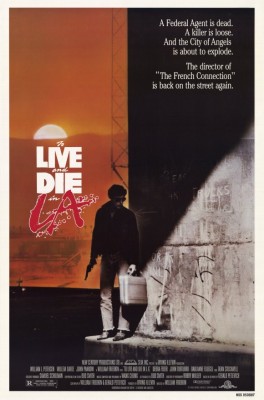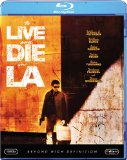| Reviews & Columns |
|
Reviews DVD TV on DVD Blu-ray 4K UHD International DVDs In Theaters Reviews by Studio Video Games Features Collector Series DVDs Easter Egg Database Interviews DVD Talk Radio Feature Articles Columns Anime Talk DVD Savant Horror DVDs The M.O.D. Squad Art House HD Talk Silent DVD
|
DVD Talk Forum |
|
|
| Resources |
|
DVD Price Search Customer Service #'s RCE Info Links |
|
Columns
|
|
|
To Live and Die in L.A.
I like MGM and Fox's approach to this release. Instead of straining to come up with new high-def extras or use up valuable disc space cramming old ones onto the Blu-ray disc, they made the savvy decision to stick the high-def movie more or less by its lonesome on the Blu-ray while simply including the standard-definition DVD version from 2003 as a kind of Disc 2, with all of that release's original supplements. Certainly there are those who will find something to complain about - "Whattya mean I gotta listen to the commentary in standard-def?!" - it's a good compromise that solves several problems at once. Not every Blu-ray release needs a complete "reboot" of new extra features; this system provides the consumer with all the good stuff from the DVD along with a standard-def DVD copy of the film, should they want that, and it frees up space on the Blu-ray disc.
Secret Service agents Richard Chance (William L. Petersen) and Jimmy Hart (Michael Green) are Treasury investigators - T-Men - closing in on a multi-million-dollar counterfeiting operation in Los Angeles masterminded by artist/counterfeiter extraordinaire Rick Masters (Willem Dafoe). Senior partner Hart, days away from retirement, unwisely stakes out the anonymous High Desert facility where the money is being printed, and is shot dead by one of Masters's bodyguards. Chance is determined to avenge his longtime friend, warning new partner John Vukovich (John Pankow), "I'm gonna bag Masters, and I don't give a shit how I do it."
Other various characters are introduced, including Chance's informant girlfriend Bianca (Debra Feuer), a parolee he screws and constantly threatens to send back to prison; Carl Cody (John Turturro), a loyal bagman for Masters who Chance arrests and unsuccessfully tries to bargain with; and Bob Grimes (Dean Stockwell), Masters's pragmatic attorney.
When Cody escapes from Chance's custody, the increasingly desperate agent hits upon a new and highly illegal scheme: steal forty grand from an unrelated diamond smuggling racket so that Chance and Vukovich can pose as counterfeiting clients, thus enabling them to get close to Masters.
To Live and Die in L.A. has an overwhelmingly nihilist, apocalyptic tone reminiscent of Robert Aldrich's late-noir classic Kiss Me Deadly (1955), with Petersen's Chance much like Ralph Meeker's riveting, violent interpretation of an unstoppable Mike Hammer. To a man (and woman), once Chance's revered partner is dead, all of the remaining characters are ultimately dirty and reprehensible, from the manipulating and manipulated Bianca to Stockwell's morally ambiguous lawyer and Darlanne Fluegel as Masters' equally pragmatic girlfriend. Kiss Me Deadly ends with an atomic explosion; To Live and Die in L.A. isn't much more optimistic.
And yet To Live and Die in L.A. simultaneously explores various and sometimes strange concepts of loyalty, from Chance's pathological obligation to his dead partner and Vulkovich's to his family of cops and to the force generally; to Cody's unaccountable loyalty toward Masters even after the latter tries to have him iced in prison; or Masters's strange pride in the service he provides his clients, a level of customer service Home Depot customers can only fantasize about.
This latter characteristic is particularly interesting. An early vignette told visually and without dialogue details the counterfeiting process in a fascinatingly realistic manner, which Friedkin films and cuts together with great effectiveness and clarity. (So real was the manufactured funny money some of it reportedly was sneaked out and put into circulation.) As one character points out, because it's only paper Masters can print any amount of money he wants and yet he's incredibly obsessive and controlling about its disposition, spending as much time retrieving and carefully burning it as he is in selling it. Outwardly Petersen and Defoe seem to be playing the standard dirty cop and psychotic criminal, but their characters and performances are much more complex than that.
Some critics pegged the film as Friedkin's attempt to do for Los Angeles what The French Connection (1971), also directed by Friedkin, does with New York. There's a lot of ammunition in support of this argument, particularly To Live and Die in L.A.'s spectacular car chase, obviously intended to rival the one in The French Connection, arguably one of the two or three most famous chase scenes in screen history.
The one in To Live and Die in L.A. tops it, not because it's more extravagant or outrageous but rather because, somewhat against the tide of things, it's realistic and believable as much as it is intense, and because Friedkin's direction and cutting of the sequence (with editor M. Scott Smith) keeps it coherent at all times; spatial relationships are never lost amid all the chaos. This is in direct contrast to something like the opening scene in Quantum of Solace (2008) which in its way is more spectacular yet completely uninteresting because it's so badly put together than the viewer has no idea at all what's going on. Friedkin (who co-wrote the script with Gerald Petievich) also adds unexpected but realistic little touches, like having Vukovich panic in the back seat of the car like a feral cat while Chance is driving, steely-eyed, up front. Reportedly, cops later told Friedkin that type of reaction happens a lot, even among cops.
And while the streets of Los Angeles are among the most familiar in the genre, overused as they were on myriad cop shows during the 1970s and early-'80s, shortly before this was made, Friedkin manages an L.A. like none seen before. Eschewing familiar locations - save for an opening sequence filmed in Century City, ironically very close to where Fox and the MGM Tower are now - Friedkin avoids all the Hollywood glamor clichés, setting much of the film in the gritty area around the Vincent Thomas Bridge and San Pedro Harbor. Other major segments are filmed southeast of downtown, or in the isolated high desert area around Lancaster, giving the city a deglamorized, heavily industrial look.
Video & Audio
Filmed for 1.85:1 projection, this 1080p 25GB* presentation is outstanding; I don't think the film has ever looked better short of fresh-out-of-the-lab 35mm premiere prints. The cinematography by legendary DP Robby Müller (whose longtime associates include Wim Wenders, Jim Jarmusch, and Lars von Trier) pops off the screen, from the blood red and lime green title design to paints used by Masters in his counterfeiting printers and the haunting deep blues of the high desert at dusk. As with Criterion's recent Lola Montès, the Blu-ray format is tailor-made for the kind of lush cinematography found in movies like To Live and Die in L.A.. Likewise outstanding is the stereo mixing, presented here in both a new DTS-HD 5.1 Master Audio mix, but also in an earlier, perfectly fine Dolby Digital 4.0. French and Spanish 3.0 Digital Dolby mixes are included, along with optional subtitles in English and Spanish.
Extra Features
To say that the supplements are identical to the December 2003 Special Edition would be imprecise: included is the December 2003 Special Edition DVD. While the Blu-ray disc does include a high-def trailer for the film, all of the other supplements are on the standard-def DVD. They include a deleted scene and alternate ending featurette; the documentary Counterfeit World: The Making of 'To Live and Die in L.A.', a photo gallery and, most significantly, an audio commentary by director William Friedkin.
Parting Thoughts
To Live and Die in L.A. is an impressive work that stands the test of time; those turned off by the film when it was first released might want to give it another chance. Friedkin impresses with his clarity and innovations in just about every scene, while Robby Müller's cinematography looks outstanding in high-def. Highly Recommended.
* Nope. I was wrong. Reader "Robb" writes, "The new blu-ray is actually 50GB and encoded in AVC, even though the back of the case claims 25gb/MPEG-2. This was released on Blu previously in Japan and parts of Europe (Germany I think?) about two years ago with the latter specs; MGM/Fox apparently went back and gave it a new superior encode for the U.S. release but neglected to change the specs on the packaging. By all accounts this one looks notably superior to the previously released Blu-ray."
Stuart Galbraith IV's latest audio commentary, for AnimEigo's Tora-san DVD boxed set, is on sale now.
|
| Popular Reviews |
| Sponsored Links |
|
|
| Sponsored Links |
|
|
| Release List | Reviews | Shop | Newsletter | Forum | DVD Giveaways | Blu-Ray | Advertise |
|
Copyright 2024 DVDTalk.com All Rights Reserved. Legal Info, Privacy Policy, Terms of Use,
Manage Preferences,
Your Privacy Choices | |||||||














